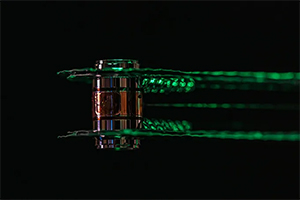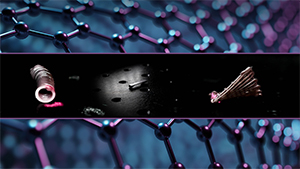LAB REPORT
Science and Technology Making Headlines
Feb. 23, 2024


An atmospheric river making landfall on the U.S. West Coast. Simulation by LLNL’s Simple Cloud-Resolving E3SM Atmosphere Model (SCREAM).
Planning for the future
From students cheating with ChatGPT to artificially generated “deepfake” videos, the downsides of artificial intelligence (AI) are causing alarm. But AI’s potential upsides also are far-reaching.
Software models that predict what will happen to our planet as the climate changes are an important tool for dealing with the environmental crisis. Peter Caldwell, lead of the Climate Modeling Group at Lawrence Livermore National Laboratory (LLNL), described them as “digital copies of the planet that we can fast-forward.”
There are two reasons to do climate modeling now, Caldwell explained: “One is to make better policy decisions. The other is to plan for the future.”
Since an increase in extreme weather events is very likely over the next 50 years, planning for the future may involve reinforcing dams and building up seawalls. To do that effectively, we need detailed predictions.
The Simple Cloud-Resolving E3SM Atmosphere Model (SCREAM), created by the LLNL along with scientists from Sandia National Laboratories and other Department of Energy labs, does just that. SCREAM can simulate the entire Earth’s future climate for years, predicting extreme weather events down to a few miles’ radius.
SCREAM doesn’t contain any AI. And yet the team needs AI to make effective use of SCREAM. That’s because the model can only run on the world’s mightiest supercomputers, as it requires a massive amount of computing power.
That’s where AI comes into play. In collaboration with the Allen Institute for AI, Caldwell’s team created machine learning algorithms to complement SCREAM. The team can have SCREAM simulate a short period of time, then use machine learning to estimate what’s likely to happen next.
“We’re using AI to emulate the behavior of the high-resolution model, just much, much faster,” Caldwell said.


AI can be used to detect failures in aging power lines. Image by Adobe Stock.
Tapping AI to detect grid defects
A rapid advancement of AI and machine-learning technology has opened the door to faster detection of potential failures in aging power lines, guiding transmission owners on how to upgrade the grid to meet clean energy and extreme weather challenges.
President Joe Biden’s executive order on AI last October emphasized caution. Safety requires “robust, reliable, repeatable and standardized evaluations of AI systems,” the order said, “as well as policies, institutions, and as appropriate, other mechanisms to test, understand and mitigate risks from these systems before they are put to use.”
There also is a case for accelerating AI’s adoption, according to Department of Energy experts speaking at a recent conference. Balancing supply and demand on the grid is becoming more complex as renewable generation replaces fossil power plants.
“There are definitely risks associated with AI,” said Colin Ponce, a computational mathematician at Lawrence Livermore National Laboratory. “A lot of utilities have a certain amount of hesitation about it because they don’t really understand what it will do.
“If we get too scared of AI and completely put the brakes on, I fear that will hinder our ability to respond to real threats and significant risk we already have evidence for, like climate change,” he said.


Lasers pummeled a small cylinder called a hohlraum (shown) in experiments aimed at generating nuclear fusion. The hohlraum acts like an X-ray oven, heating a capsule within that holds the heavy types of hydrogen that act as the fuel. Photo by Jason Laurea/LLNL.
A lot of artwork goes into science
One of nuclear fusion’s biggest advances wouldn’t have happened without some impeccable scientific artistry.
In December 2022, researchers at Lawrence Livermore National Laboratory created fusion reactions that produced an excess of energy — a first. In the experiment, 192 lasers blasted a small chamber, setting off fusion reactions — in which smaller atomic nuclei merge to form larger ones — that released more energy than initially kicked them off. It’s a milestone known as “ignition,” and it has been decades in the making.
Now, researchers have released details of that experiment in five peer-reviewed papers published online Feb. 5 in Physical Review Letters and Physical Review E. The feat demanded an extraordinary level of finesse, tweaking conditions just so to get more energy out of the lasers and create the ideal conditions for fusion.
After decades of slow progress on fusion, scientists are beginning to get their atomic orchestras in sync.


As described in the paper, the LLNL team, along with their collaborators from Harvard University, North Carolina State University, and the University of Pennsylvania, used a direct ink writing printing technique to build a variety of light-responsive objects, including cylinders that could roll, asymmetric “crawlers” that could go forward, and lattice structures that oscillated. By combining shape morphing with photoresponsivity, researchers said the new type of material could change the way people think about machines and materials. Photos courtesy: Michael Ford/LLNL.
Can you see the light
Researchers have developed a new 3D-printable, light-responsive material that can be used to create machines that move without electronics.
These “soft robots” or “soft machines” are made of a new material, a so-called liquid crystal elastomer (LCE), in which gold nanorods are embedded. So far, the researchers have successfully used their material to print rollable cylinders, forward-moving “crawlers” and lattice structures that oscillate when exposed to laser light.
“Rigid robots might not be ideal for interacting with humans, so we need systems and materials that are more compliant,” said lead author of the research Michael Ford, a postdoctoral fellow in the High Performance Materials group at Lawrence Livermore National Laboratory. “You start with the components that make up our robots, and one of those components is an actuator. This is where these materials come into play; They could potentially be an actuator.
“It reduces computational complexity; They make a material that eliminates the need for onboard electronics and replaces them with a single material that can do all of these things,” he said. “This will allow you to put more computational effort into another component or power other sensors, which would not have been possible with traditional rigid materials.”

Microbes can break down any molecule in soil. Image by Adobe Stock.
Dishing the dirt on soil microbes
With civilization continuing to pump ever-increasing amounts of carbon dioxide into the atmosphere, perhaps plants — nature’s carbon scrubbers — might be able to package up some of that excess carbon and bury it underground for centuries or longer.
That hope has fueled increasingly ambitious climate change mitigation plans. Over the past 10 years or so, soil science has undergone a quiet revolution, akin to what would happen if, in physics, relativity or quantum mechanics were overthrown. Except in this case, almost nobody has heard about it — including many who hope soils can rescue the climate.
In the second half of the 20th century, powerful new microscopes and techniques such as nuclear magnetic resonance and X-ray spectroscopy allowed soil scientists for the first time to peer directly into soil and see what was there, rather than pull things out and then look at them.
What they found — or, more specifically, what they didn’t find — was shocking: there were few or no long “recalcitrant” carbon molecules — the kind that don’t break down. Almost everything seemed to be small and, in principle, digestible.
“We don’t see any molecules in soil that are so recalcitrant that they can’t be broken down,” said Jennifer Pett-Ridge, a soil scientist at Lawrence Livermore National Laboratory. “Microbes will learn to break anything down — even really nasty chemicals.”





